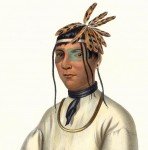
A-qua-o-da, which signifies Creeping out of the Water
An Ogibway (Ojibway)
The largest freshwater lake in the world is Lake Superior, through the centre of which runs the boundary line between the United States of America and the Dominion of Canada. The Indians call it the “Ojebway Kecheguramee,” that is–literally translated–the Great water of the Ojebways, or as they are often called the Chippeways.
The Ojebways are an extensive Indian tribe spreading over a large part of Canada, the Northern States, and the North West; specimens of their language and customs appear in Longfellow’s song of Hiawatha. Lake Superior may be regarded as the centre of their ancient possessions. Along its northern shores, and back into the interior they still roam in wild freedom, hunting, and fishing, and paddling their birch-bark canoes;–but in more civilized places, they are confined to reserved lands set apart for them by the Dominion Government, and many of them now gain their living by farming or by working for the neighbouring white people.
The Ojebway Indians are now just in that transition stage in which they particularly require a helping hand to lift them up to a respectable position in life, and to afford them the means of gaining their livelihood as a civilised Christian people. As one of their own Chiefs has said, “the time is passed for my people to live by hunting and fishing as our forefathers used to do; if we are to continue to exist at all we must learn to gain our living in the same way as the white people.”
It is with the view of making the wants of these poor people known, and of increasing the interest in a work which amid many difficulties, has for the past ten years been carried on among them, that these pages are written. The writer will tell what have been his experiences with the Indians since he first came to settle among them as a Missionary, and will describe how God in His providence gradually opened the way for him, how dangers were met, and difficulties overcome, and how in the end two Institutions for the Christian training and civilization of Indian children were brought into existence; the one called the _Shinywauk Home_, with accommodation for about seventy Indian boys, and the other called the _Wavanosh Home_ with room for about thirty Indian girls,–both of them built, and now in active operation, at Sault Ste. Marie, Ontario, at the south-eastern extremity of Lake Superior.
- How It Came About That I Went To Canada
- First Missionary Experiences
- Our Arrival At Sarnia
- Kettle Point
- Indian Names Given
- Christmas On The Reserve
- Mission Work At Sarnia
- The Bishop’s Visit
- First Visit To Garden River
- Baptism Of Pagans
- The Red River Expedition
- Changes In Prospect
- Roughing It
- Chief Little Pine
- Our First Winter In Algoma
- Chief Buhkwujjenene’s Mission
- An Indian Chief In England
- A Trial Of Faith
- Learning To Know My People
- A Wedding And A Death
- The Opening Of The First Shingwauk Home
- Fire! Fire!
- After The Fire
- Prospects Of Re-Building
- Laying The Foundation Stone
- A Trip To Batcheewauning
- The Winter Of 1874-5
- The New Shingwauk Home
- Runaway Boys
- Charlie And Ben
- A Trip Up Lake Superior
- Coasting And Camping
- Up The Neepigon River
- Thirty Years Waiting For A Missionary
- The Pagan Boy–Ningwinnena
- Baptized–Buried
- The Wawanosh Home
- A Sad Winter
- William Sahgucheway
- Our Indian Homes
- A Pow-Wow At Garden River
- Glad Tidings From Neepigon
